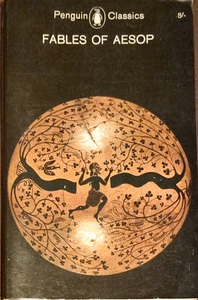Take a photo of a barcode or cover
informative
lighthearted
medium-paced
inspiring
reflective
medium-paced
Plot or Character Driven:
A mix
Strong character development:
Complicated
Loveable characters:
Complicated
Diverse cast of characters:
Yes
Flaws of characters a main focus:
Yes
funny
informative
inspiring
lighthearted
reflective
medium-paced
Plot or Character Driven:
N/A
Strong character development:
N/A
Loveable characters:
N/A
Diverse cast of characters:
N/A
Flaws of characters a main focus:
N/A
I read an abridged version of Assops fables (80+ stories), as I was looking for a sample of these works and overall have such mixed emotions across the anthology. The tales of folly I enjoyed much less than parables showing the correct action to take. There were a few I recognized and did not know they were attributed to Assop, and some seemed very similar to biblical parables. A few I liked included the Lion and the Mouse, Androcles and the Lion, the Belly and the Members, the Fisher and the Little Fish, the Crow and the Pitcher and the Ass's Brains.
adventurous
challenging
dark
emotional
funny
mysterious
reflective
informative
fast-paced
Plot or Character Driven:
Character
Strong character development:
Yes
Loveable characters:
No
Diverse cast of characters:
Complicated
Flaws of characters a main focus:
Yes
I'd heard a lot of Aesop's fables, here and there, but I'd never read them all. There are a lot, it turns out, and most are fewer than 100 words long.
They all have similar elements, but these elements aren't there in all of them. Sometimes animals stand in for human traits (like the fox almost always represents cleverness, the lion danger and strength, the wolf is sneaky and scary, the crow a big dope, the monkey cute and clever), but some of the stories have only human characters. The stories don't even all have explicit lessons at the end; sometimes it's spoken by a character in the fable.
The most interesting part of reading these fables is that the lessons at the end have become clichés in our time (and probably before then, too), and the stories were written in the 7th century BC. Some are timeless, but surely some attitudes have updated since then. I refer to the two that were explicitly sexist, and the many that implied that slavery is a normal, everyday thing.
My favorite fable, which I've never heard before, is about wolves who complain to the sheep that they're not given the chance, because the dogs bark and bite and chase them off when they try to get close. The sheep get rid of the dogs, and are torn to pieces for their stupidity. It reminded me of the tone argument, the precept that one needs to be nice about it when pointing out others' prejudices.
Most of the stories can likely be similarly updated, because the lesson isn't always explicit. It may well have been meant for one situation, but its universal application is what's made it survive this long.
The end of the edition I read contained some biographical information about Aesop, which adds some more context to these tales. It doesn't address any of the controversy about his identity, but presents the story of his probable life at Samos and death at Delphi.
If you think you know the fables, I recommend you read through them, at some point, to get a more full view. If nothing else, they're useful as cultural reference to a place and time when people still feared wolves.
They all have similar elements, but these elements aren't there in all of them. Sometimes animals stand in for human traits (like the fox almost always represents cleverness, the lion danger and strength, the wolf is sneaky and scary, the crow a big dope, the monkey cute and clever), but some of the stories have only human characters. The stories don't even all have explicit lessons at the end; sometimes it's spoken by a character in the fable.
The most interesting part of reading these fables is that the lessons at the end have become clichés in our time (and probably before then, too), and the stories were written in the 7th century BC. Some are timeless, but surely some attitudes have updated since then. I refer to the two that were explicitly sexist, and the many that implied that slavery is a normal, everyday thing.
My favorite fable, which I've never heard before, is about wolves who complain to the sheep that they're not given the chance, because the dogs bark and bite and chase them off when they try to get close. The sheep get rid of the dogs, and are torn to pieces for their stupidity. It reminded me of the tone argument, the precept that one needs to be nice about it when pointing out others' prejudices.
Most of the stories can likely be similarly updated, because the lesson isn't always explicit. It may well have been meant for one situation, but its universal application is what's made it survive this long.
The end of the edition I read contained some biographical information about Aesop, which adds some more context to these tales. It doesn't address any of the controversy about his identity, but presents the story of his probable life at Samos and death at Delphi.
If you think you know the fables, I recommend you read through them, at some point, to get a more full view. If nothing else, they're useful as cultural reference to a place and time when people still feared wolves.
reflective
medium-paced
Plot or Character Driven:
A mix
Strong character development:
No
Loveable characters:
Complicated
Diverse cast of characters:
Yes
Flaws of characters a main focus:
Yes
lighthearted
fast-paced
Plot or Character Driven:
Character
Strong character development:
No
Loveable characters:
No
Diverse cast of characters:
Yes
Flaws of characters a main focus:
Yes
adventurous
challenging
funny
sad
slow-paced
Plot or Character Driven:
Character
Strong character development:
Complicated
Loveable characters:
Yes
Diverse cast of characters:
Yes
Flaws of characters a main focus:
Yes




